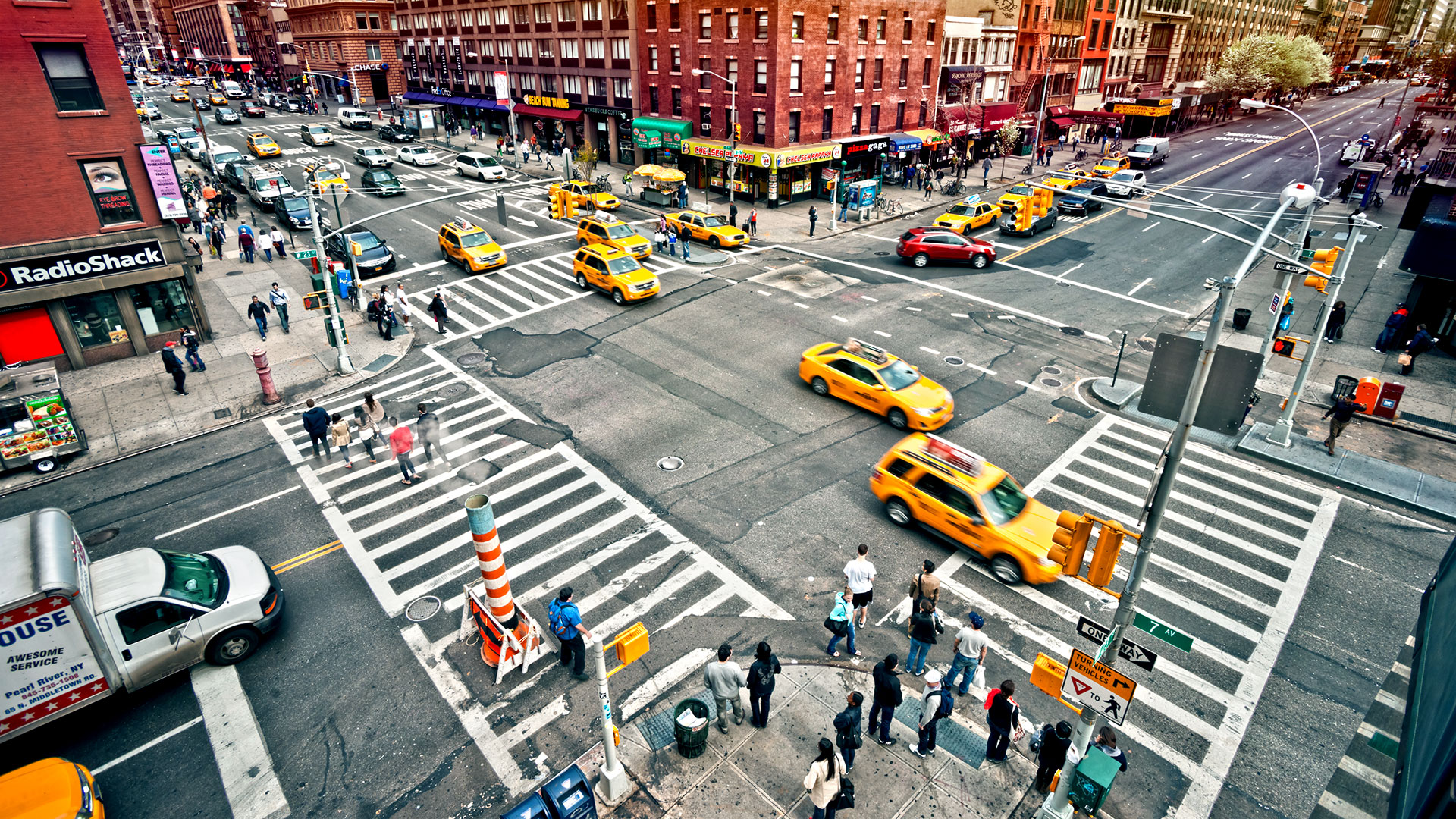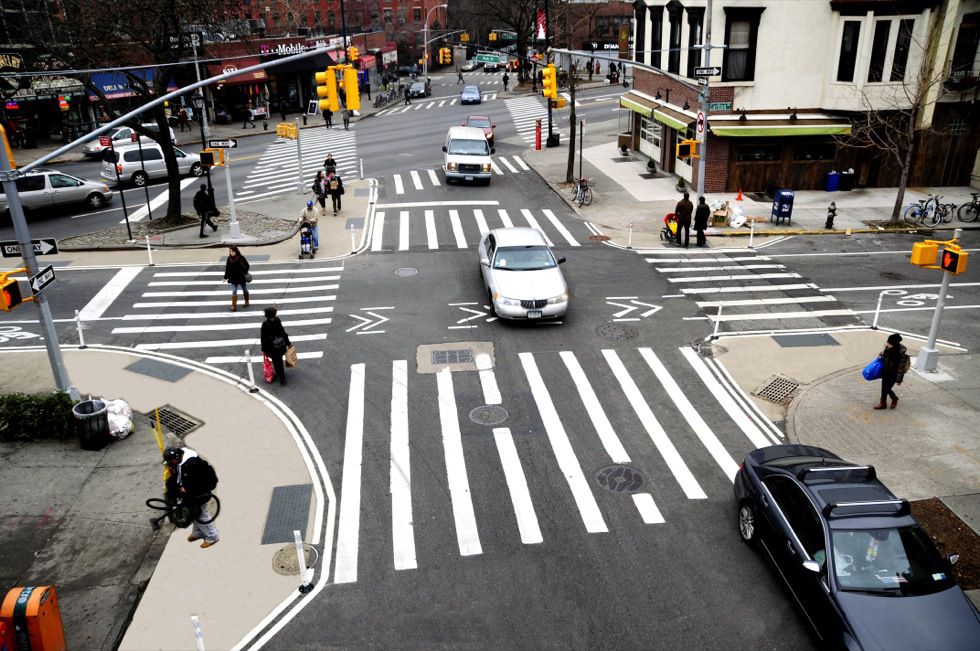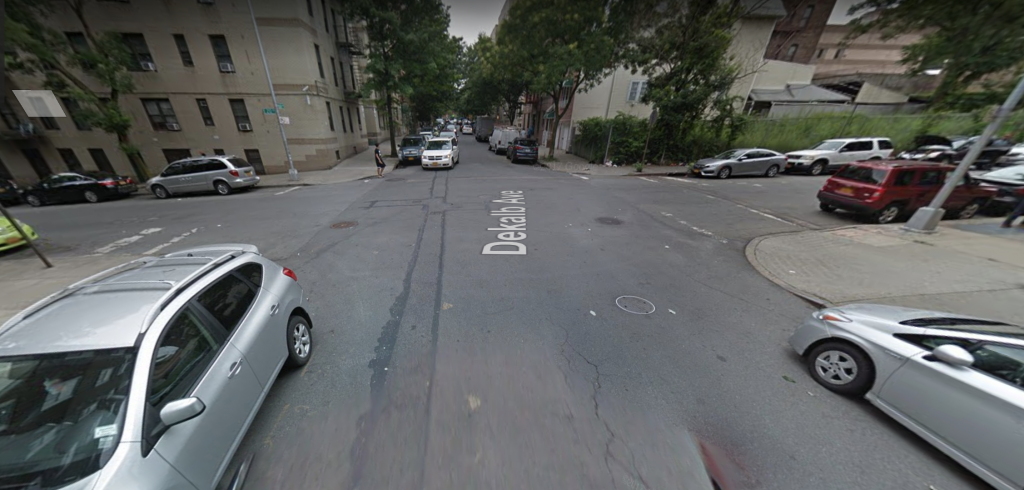
Summary & Quick Facts
- There are two kinds of crosswalks to be aware of: marked crosswalks and unmarked crosswalks.
- Marked crosswalks are the highlighted by a pattern of lines on the street that guide pedestrians into proper crossing paths.
- An Unmarked crosswalk is a pathway between opposite sides of a roadway at an intersection that does not have distinct lines.
- Drivers are not allowed to Stop, Stand or Park in any crosswalk, marked or unmarked.
- A parking ticket for stopping, standing or parking in a crosswalk will set you back $115.
Crosswalk: The Nexus Of New York
Getting around NYC is a constant test of nerves for drivers, bikers, pedestrians and everyone in between. Pedestrians have to dodge nonsensically swerving tourists who don’t know how to look anywhere but up. Bikers have to constantly weave in and out of the gauntlet of cars and trucks parked in the bike lane. And let’s just say potholes aren’t the only things that drivers have to dodge when cruising the city streets. While each group has their own place on the road, there is one place where all parties meet: the crosswalk.
The crosswalk in NYC is the nexus where all stakeholders of the city streets have to deal with each other. One thing that all pedestrians, bikers, and drivers should know is that the crosswalk is a sacred space. Moreover, its a sacred space that should never be violated! “What’s the big deal?”, you may ask. At first glance, crosswalks seem to simply be just some white paint on the asphalt. However, crosswalks may not always seem so apparent. Not knowing the differences can leave you with a hefty $115 parking ticket. Moreover, with the Vision Zero Program in full swing, now more than ever is it important for drivers to really understand crosswalks. This article will break down exactly everything you need to know about them.
What Is A Marked Crosswalk?
Simply put a crosswalk is a place designated for pedestrians to cross a street. Crosswalks are designed to keep pedestrians grouped together so they can be seen by bikers and motorists. They are also designed to allow pedestrians to cross safely through the flow of traffic on the road. In NYC, there are two kinds of crosswalks to be aware of: marked crosswalks and unmarked crosswalks. Here is how the city defines a marked crosswalk in section § 4-01 of the New York City Department of Transportation Traffic Rules:
Crosswalk. (i) Marked crosswalk. That part of a roadway defined by two parallel lines or highlighted by a pattern of lines (perpendicular, parallel or diagonal used either separately or in combination) that is intended to guide pedestrians into proper crossing paths.

The image above provides great examples of what marked crosswalks look like in NYC. Crosswalks typically comprise of highly visible, white lines that are parallel with the direction of traffic and perpendicular to the path that pedestrians take when crossing the street. Nonetheless, crosswalks can vary in looks ranging from the basic crosswalk (two simple lines) to “continental” or “piano” crosswalks (thick white lines perpendicular to the traffic lane) to “zebra” crosswalks (white lines at an angle).
What Is An Unmarked Crosswalk?
Now let’s get to the unmarked crosswalk, here’s how the city defines it:
“(ii) Unmarked crosswalk. That part of a roadway, other than a marked crosswalk, which is included within the extensions of the sidewalk lines between opposite sides of the roadway at an intersection, provided that (A) the roadway crosses through the intersection rather than ending at the intersection, and/or (B) all traffic on the opposing roadway is controlled by a traffic control device.”

The definition for unmarked crosswalks is a lot murkier than that for marked crosswalks. But in layman’s terms, an unmarked crosswalk is the pathway between opposite sides of a roadway at an intersection but do not have distinct lines. The image above shows an intersection up in the Bronx. The unmarked crosswalk is the pathway for pedestrians that links the two curb cuts perpendicular to Dekalb Ave. If you notice, you can see a pedestrian on the far left corner of the street getting ready to cross the unmarked crosswalk.
Nevertheless, it could be inferred that an unmarked crosswalk is any part of an intersection that forms a straight line from one curb cut on one side of the road to the other. Whether marked or unmarked, drivers should yield to pedestrians at all intersections.
However, if you’re acting as a pedestrian, you shouldn’t count on drivers stopping at an unmarked crosswalk, even if you believe that you have the right-of-way. Without traffic control signals to remind drivers to slow for you, crossing at an unmarked intersection could be dangerous.
Rules Drivers Should Remember About Crosswalks
If you’re a driver in NYC wondering what is the proper thing to do when approaching a crosswalk, the city lays it out clear and simple in Section 4-04 of the New York City Department of Transportation Traffic Rules:
“(b) Right of way in crosswalks. (1) Operators to yield to pedestrians in crosswalk. When traffic control signals or pedestrian control signals are not in place or not in operation, the operator of a vehicle shall yield the right of way to a pedestrian crossing a roadway within a crosswalk when the pedestrian is in the path of the vehicle or is approaching so closely thereto as to be in danger.”
Drivers should always approach a crosswalk with caution and always defer to the safety of all pedestrians. If you see a pedestrian wanting to cross or already crossing, slow down to a complete stop and give them all the time they need to cross the street safely to the other side. While the onus of pedestrian safety is largely on drivers, the city does regulate how pedestrians can cross. Here’s what they have to say:
(2) Pedestrians shall not cross in front of oncoming vehicles. Notwithstanding the provisions of (1) of this subdivision (b), no pedestrian shall suddenly leave a curb or other place of safety and walk or run into the path of a vehicle which is so close that it is impossible for the operator to yield.
Let’s be real, jaywalking is a storied NYC past-time, New Yorkers do it all the time. Even though jaywalking isn’t strictly regulated anymore, pedestrians should still use common sense. Please pedestrians, abide by traffic regulation and play your part in keeping roads safe by not jaywalking.
Crosswalks And Parking tickets
Knowing what to do with crosswalks can be very tricky for drivers, especially when it comes to parking. According to the NYC DMV, parking or standing within 20 feet of a marked pedestrian crosswalk at an intersection is illegal and can result in a ticket. Here is the law on the City books stipulating this:
| Code 50 | Stopping, standing or parking in a crosswalk. Note: Crosswalks are not always identified by painted street markings. | $115 |
In fact, we’d argue that even beyond parking, simply stopping in a crosswalk to let out a passenger or drop something off is an easy way to get yourself a parking ticket. Sure, you can totally get away with parking right before the lines delineating where an intersection begins. Still, we think its best to make sure that you give an appropriate amount of space between your car and the crosswalk. Here are some other things to keep in mind about crosswalks:
- Drivers cannot enter an intersection and its crosswalks unless there is sufficient unobstructed space beyond the intersection and its crosswalks.
- No driver should back a vehicle into an intersection or over a crosswalk in any event unless it can be done safely.
- If your car breaks the plane of the crosswalk while it’s standing, stopped or parked, even by an inch you will get a parking ticket.
If you do happen to get a crosswalk parking ticket down the road, check out our articles on how to pay or how to fight them, we promise you won’t regret it.
